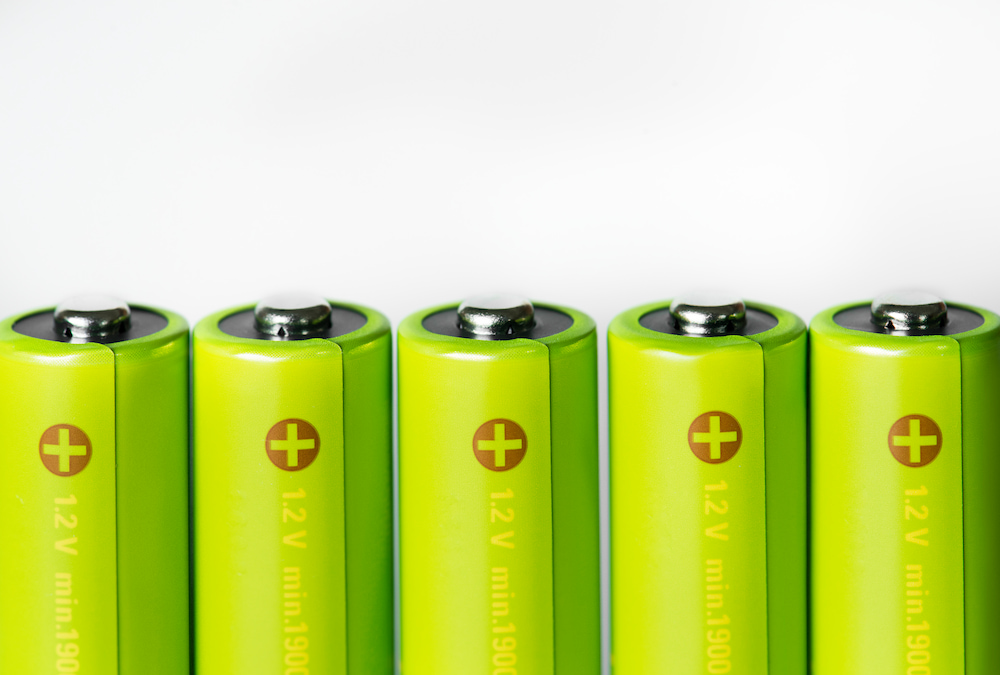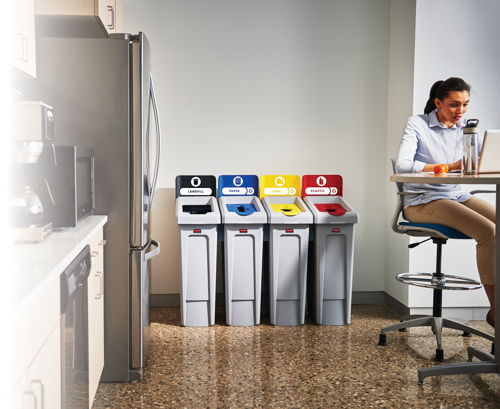
Alkaline, Lead-acid and lithium-ion batteries are found everywhere in commercial settings, from solar panels, vehicles, remote controllers, tools, and other electronic devices. Depending on the materials used to produce them, their use, and end-of-life treatment, their impact on the environment varies.
Batteries come in many types—each with its own use, composition, and recyclability potential. Understanding these differences is key to effective battery recycling and reducing battery waste from entering our landfills and recycling bins.
Here are the most common battery types:
Lead-acid batteries: Often used in car batteries and exit lighting, this older yet durable technology is one of the most recycled, with up to 99% of materials recovered according to Battery Council International.
Lithium-ion batteries: Found in mobile phones, laptops, digital cameras, and power tools. While powerful and rechargeable, these lithium ion batteries are rarely recycled due to complex composition.
Alkaline batteries: These single use batteries are commonly found in remote controls, button batteries, and household items like clocks and smoke detectors. Many regions now accept them through specific recycling programs such as B-cycle.
Nickel-based batteries: Used in computer batteries, they’re rechargeable batteries and can be recycled through drop-off points for used batteries.
Improper disposal of any battery type risks exposing toxic materials, damaging battery terminals, or causing produce sparks—making proper sorting and safe handling essential at the electrical connection point and beyond.
According to UNEP and the International Lead association, approximately 86% of the world's lead is used to manufacture lead-acid batteries. The rising global demand for motor vehicles, fueled by economic development, and the growing reliance on renewable energy, which requires battery storage, are directly increasing the need for these lead-acid batteries (WHO, 2017).
Given that each battery can contain up to 10 kilograms of lead, used lead-acid batteries (WLAB/ULAB) are a significant source of recyclable lead. This valuable commodity supports a profitable global industry, encompassing both formal and informal operations, dedicated to recovering these batteries.

According to the Battery Council International, 99% of lead-acid batteries materials are recyclable, being possible to recover the lead as well as the plastic tray of the battery. The liquid at the bottom of the battery made up of acid and water, that can be recovered and reused as such or removing the water so that only the acid is finally used.
Improper disposal of batteries, especially when tossed into the general waste bin, can have long-lasting environmental consequences. Many used batteries still end up in landfills or incinerators. Many used batteries still end up in landfills or incinerators. When damaged or exposed to heat, batteries—particularly lithium ion, lead acid batteries, and acid batteries—can leak toxic materials into the soil and waterways, harming ecosystems and contaminating groundwater.
The problem isn’t just pollution—it’s also resource depletion. Batteries contain valuable materials such as lithium, lead, copper, and cobalt, which are finite and energy-intensive to mine. Failing to recycle batteries, whether from mobile phones, digital cameras, power tools, or button batteries, wastes resources that could otherwise be recovered.
Worse still, incorrect disposal of rechargeable batteries or single use batteries can produce sparks, damage battery terminals, or pose safety risks at the electrical connection point.
According to the Asia Pacific Battery Recycling Market Report 2025, the global Battery Recycling Market size was estimated at USD 27812.2 Million, out of which Asia Pacific held the market of around 23% of the global revenue with a market size of USD 6396.81 million in 2024 and will grow at a compound annual growth rate (CAGR) of 12.8% from 2024 to 2031.
Over 200,000 tonnes of batteries, equivalent to 737 million units or 8,313 million Equivalent Battery Units (EBUs), were sold in Australia in 2021 according to Australian Battery Stewardship Council. That same year, an estimated 156,000 tonnes of batteries were collected for recycling, achieving an 87% collection rate across all battery sizes.
Battery use is essential for many important products which support a sustainable and circular future and battery recycling is imperative, however improper battery handling and recycling is an important cause of environmental contamination and human exposure. This is a concern because of the significant and long-lasting impacts of heavy metals and chemicals exposure on human health.
Proper handling of used batteries in commercial and industrial environments is essential—not only for environmental protection, but also for occupational health and safety. Whether dealing with household batteries, mobile phone batteries, or acid batteries from exit lighting and machinery, following best practices can reduce the risk of chemical leaks, fires, or worker exposure to hazardous materials.
Here are recommended best practices for safe battery handling:
All used or easily removable batteries should be stored whole and undamaged. Businesses should never dismantle, drain, or attempt to remove internal parts like chemicals or metals. Breaking batteries can release toxic substances and cause short circuits.
Store batteries in acid-resistant containers in a cool, dry, and ventilated area, well away from heat sources or flammable materials. This is especially important for acid batteries used in emergency lighting systems. Group batteries by chemistry type (e.g., lithium-ion, lead-acid, alkaline) to prevent reactions or cross-contamination.
Cover battery terminals with non-conductive tape to prevent accidental sparks or discharge—especially critical for mobile phone batteries, laptop batteries, and new batteries with charge remaining.
Establish a dedicated, labelled battery drop-off zone for staff or facility maintenance teams. Include clear signage and procedures to support your company’s recycling program or partnerships with approved recyclers.
Only work with certified battery recycling providers who follow regulatory guidelines. In Australia, programs like B-cycle help businesses safely recycle all battery types, from button batteries to bulk industrial cells.
Effective battery waste management isn’t just good practice—it’s a business imperative. For organisations using mobile phone batteries, acid batteries, or other battery types in daily operations, creating a dedicated battery waste stream is key to reducing environmental harm, recovering valuable materials, and ensuring workplace safety.
When batteries are disposed of alongside general waste, it limits the potential for proper recycling and increases the risk of contamination. Segregating battery waste supports compliance, protects staff, and contributes to a more sustainable, circular economy.
Rubbermaid Commercial offers a range of durable, acid-resistant waste containers designed for safe battery collection and handling in commercial settings. With the right infrastructure in place, your business can go beyond compliance and lead the charge in responsible waste practices.
Explore Rubbermaid’s waste management products to start building a safer, cleaner battery disposal system.